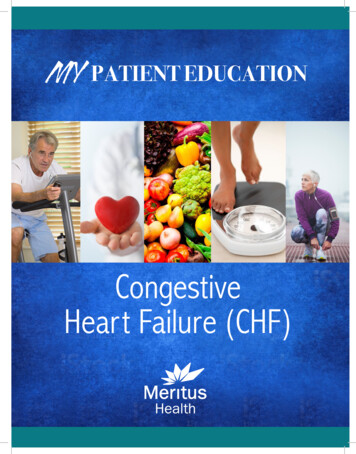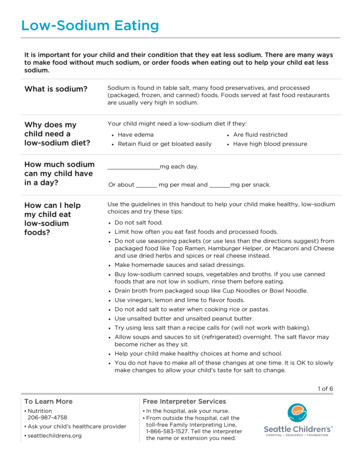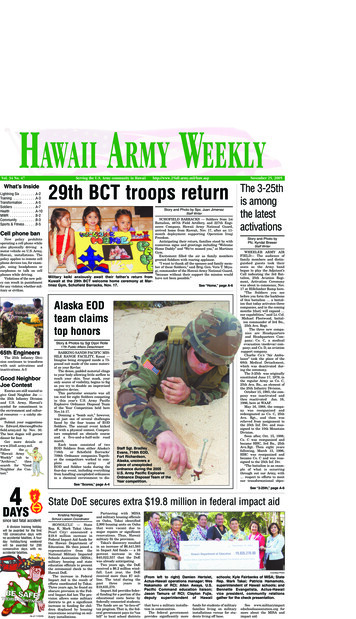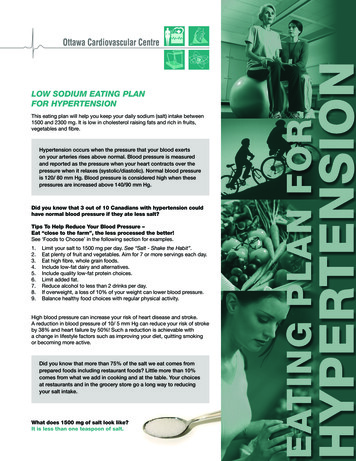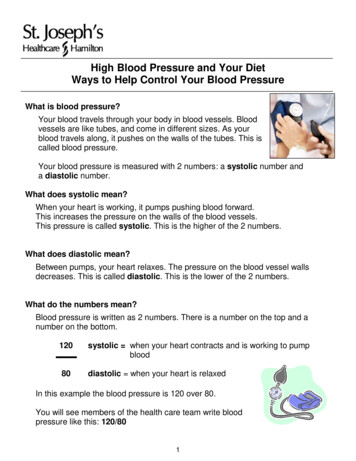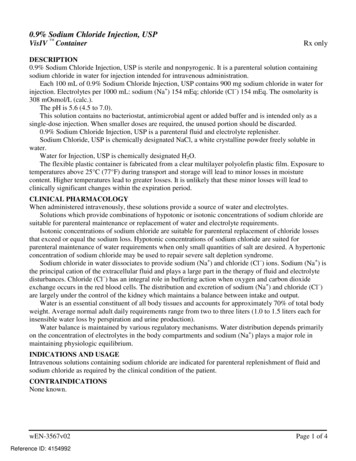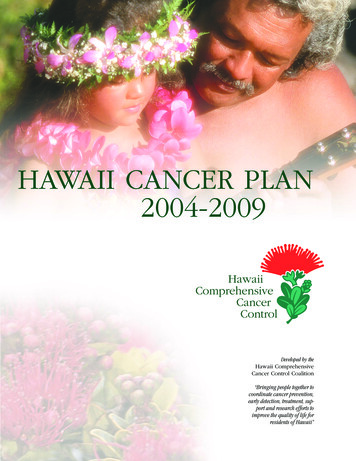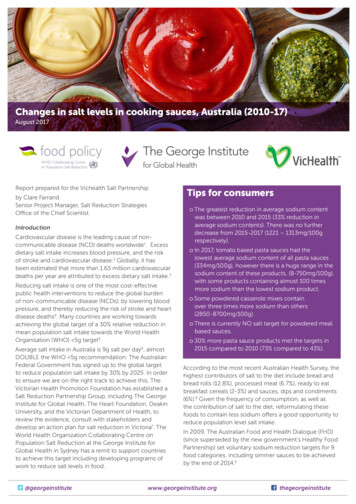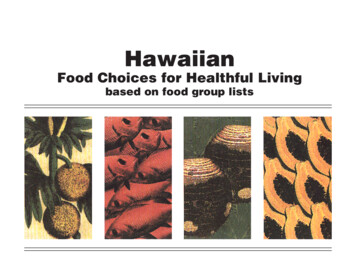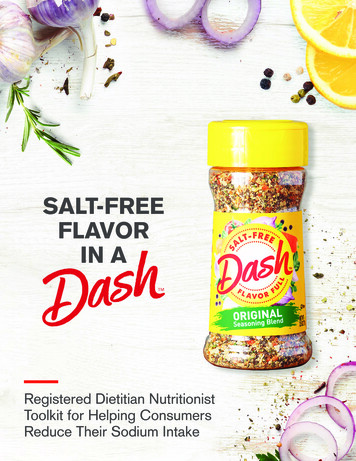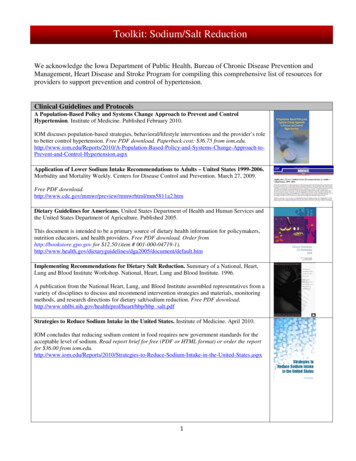
Transcription
Toolkit: Sodium/Salt ReductionWe acknowledge the Iowa Department of Public Health, Bureau of Chronic Disease Prevention andManagement, Heart Disease and Stroke Program for compiling this comprehensive list of resources forproviders to support prevention and control of hypertension.Clinical Guidelines and ProtocolsA Population-Based Policy and Systems Change Approach to Prevent and ControlHypertension. Institute of Medicine. Published February 2010.IOM discuses population-based strategies, behavioral/lifestyle interventions and the provider’s roleto better control hypertension. Free PDF download. Paperback cost: 36.75 from ent-and-Control-Hypertension.aspxApplication of Lower Sodium Intake Recommendations to Adults – United States 1999-2006.Morbidity and Mortality Weekly. Centers for Disease Control and Prevention. March 27, 2009.Free PDF mm5811a2.htmDietary Guidelines for Americans. United States Department of Health and Human Services andthe United States Department of Agriculture. Published 2005.This document is intended to be a primary source of dietary health information for policymakers,nutrition educators, and health providers. Free PDF download. Order fromhttp://bookstore.gpo.gov for 12.50 (item # elines/dga2005/document/default.htmImplementing Recommendations for Dietary Salt Reduction. Summary of a National, Heart,Lung and Blood Institute Workshop. National, Heart, Lung and Blood Institute. 1996.A publication from the National Heart, Lung, and Blood Institute assembled representatives from avariety of disciplines to discuss and recommend intervention strategies and materials, monitoringmethods, and research directions for dietary salt/sodium reduction. Free PDF t/hbp/hbp salt.pdfStrategies to Reduce Sodium Intake in the United States. Institute of Medicine. April 2010.IOM concludes that reducing sodium content in food requires new government standards for theacceptable level of sodium. Read report brief for free (PDF or HTML format) or order the reportfor 36.00 from 1
Toolkit: Sodium/Salt ReductionEducation MaterialsProvider EducationSodium Reduction: A Public Health Imperative; Darwin Labarthe, M.D., M.P.H., PhD,Director, Division for Heart Disease and Stroke Prevention, National Center for Chronic DiseasePrevention and Health Promotion. Presentation given May 2010.Presentation given at an American Public Health Association Webinar. Presenter Darwin Labarthe,M.D., M.P.H., PhD, describes the urgent need for sodium reduction change, the current sodiumclimate in the U.S. and speaks about the Institute of Medicine’s sodium report. Free download inPowerPoint format.https://docs.google.com/viewer?a v&q C43-C779-4AE5-A64E655108991FAE/0/. Sodium Reduction: A Public Health Imperative%2BDarwin Labarthe%2BMay 2010&hl en&gl us&pid bl&srcid ADGEEShX3LkNDGU5wbrlj QokcMCLYIZiyIeWPFY-a0AAqAtvoxk2w jfiRBUDm2wrnTG0SCTyNlOiejIIbPEiZP&sig AHIEtbR7VRuy3T-VTfJWvbS0OC5jwAK3zASodium Reduction: The Current Landscape; Jonathan E. Fielding, M.D., M.P.H., M.B.A.,Director of Public Health and Health Officer, L.A. County Department of Public Health, Professorof Health Services and Pediatrics, Schools of Public Health and Medicine, UCLA. Presentationgiven May 2010.Presentation given at an American Public Health Association Webinar. Presenter Jonathan E.Fielding, M.D., M.P.H., M.B.A., compares the current state of sodium reduction in the U.S.compared to other countries. Free PDF -70C3-43B1-AB6E58B3AD518CD8/0/Sodium Fielding.pdfSodium: Point/Counterpoint – Centers for Disease Control, Heart Disease and Stroke Prevention.May 2010.A document for health program staff and partners to anticipate and respond to possible questionsabout sodium reduction. Free PDF download.http://www.in.gov/isdh/files/Sodium Point Counterpoint 5-24-10.pdfSodium: Q&A – Centers for Disease Control, Heart Disease and Stroke Prevention. May 2010.Answers general questions about sodium reduction (for health care providers and patients). FreePDF download.http://www.cdc.gov/salt/pdfs/Sodium QandA.pdf2
Toolkit: Sodium/Salt ReductionSodium: the facts – Centers for Disease Control, Heart Disease and Stroke Prevention. April2010.Fact sheet describing how an increased salt/sodium intake can increase blood pressure, adescription of salt/sodium and facts about sodium within the American food supply. Free PDFdownload.http://www.cdc.gov/dhdsp/data statistics/fact sheets/docs/Sodium Fact Sheet.pdfStrategies to Reduce Sodium Intake in the United States; Lawrence J. Appel, M.D., M.P.H.Member IOM Committee on Strategies to Reduce Sodium Intake. Presentation given May 2010.Presentation given at an American Public Health Association Webinar. Presenter Lawrence J.Appel, M.D., M.P.H., describes the current state of sodium reduction in the United States comparedto other countries and outlines strategies to decrease the consumption of sodium by Americans.Free PDF cation MaterialsPatient EducationBLUE, The Salt you Never See – How to Spot Sodium Traps. Wellmark Blue Cross and BlueShield. Spring 2010.This article describes how much sodium we really need in comparison to how much sodium is inprocessed foods. Contains great tips to lower your sodium intake while cooking at home or eatingat a efits/Docs/BlueMag/MedSupp/SeniorBlue Summer10 IA.pdfGet Smart About Salt. American Dietetic Association. www.eatright.org. 2007.This flyer can be distributed to your pre-hypertensive and hypertensive patients. It describes thehealth benefits for reducing salt without reducing taste and flavor, the sources of sodium in foods,tips for the low-salt diner, and gives an easy recipe for Spicy Steak Fries with only 10 mg ofsodium, 7 grams of fat and 200 calories per serving. Free PDF alt.pdfHealth Bulletin: Cut the Salt! – New York City Department of Health and Mental Hygiene.Volume 8. Number 5. 2009.Tips for people who want to reduce their salt/sodium consumption. Includes photographs detailinghow to read a food public/dohmhnews8-05.pdf3
Toolkit: Sodium/Salt ReductionHow to Follow a Low-Sodium Diet. The Heart Failure Society of America (HFSA). 2009.Describes a low-sodium diet and provides steps to keep you on track. Includes a listing of foodshigh/low in sodium. Free PDF yle Changes to Make to Lower Blood Pressure – Without Medication. 2010.Lists behaviors a person can change to lower blood pressure. Contains information about foodlabeling and has a salt-free seasoning guide.www.dietitiancenter.com/sodium.aspxReduce sodium, increase potassium. Iowa State University Extension. May 2009.Explains how to find sodium on the Nutrition Facts Panel. There is a brief True/False quiz to showhow sodium savvy the reader is, gives tips for reducing sodium, explains the difference indefinitions for sodium free, very low sodium, low sodium and reduced or less sodium on foodlabels. It also suggests alternatives for salt-free seasonings for different foods. Free PDF temDetail.aspx?ProductID 12118Shaking Your Salt Habit – American Heart Association. (2008). Retrieved from KRAMESPatient Education (2010) website: www.krames.com.Presents very easy to read and understand information about the need to reduce salt and sodium inthe diet. It presents information about the DASH eating plan; sources of sodium in processed foods;the benefits of potassium; making good food choices; and cooking with less salt and more flavor.Order 50 brochures for 69.65 (item #50-1627) from krames.com.https://www.krames.com/OA HTML/ibeCCtpItmDspRte kra.jsp?JServSessionIdrootistore3 Nr65TrQjGp2TxpQOUahmKa30&dbprod prod N6YPtbu9DeXq79M hDxISRXI:S&dbprod prod pses FD217527FC90F6201F82FA4B11209F&item 670410Sodium: How to tame your salt habit now. By Mayo Clinic Staff. 2010.Article describes why sodium is beneficial to the body (when used in moderation). Discusses howto find ingredients within food that may signal that they are high in 0284Sodium: Q&A – Centers for Disease Control, Heart Disease and Stroke Prevention. May 2010.Answers general questions about sodium reduction (for health care providers and patients). FreePDF download.http://www.cdc.gov/salt/pdfs/Sodium QandA.pdf4
Toolkit: Sodium/Salt ReductionSodium: the facts – Centers for Disease Control, Heart Disease and Stroke Prevention. April 2010.Fact sheet describing how an increased salt/sodium intake can increase blood pressure, adescription of salt/sodium and facts about sodium within the American food supply. Free PDFdownload.http://www.cdc.gov/dhdsp/data statistics/fact sheets/docs/Sodium Fact Sheet.pdfTalk With Your Health Care Provider About High Blood Pressure, US Department of VeteranAffairs, US DHHS, Agency for Healthcare Research and Quality (AHRQ), and US PreventiveServices Task Force, 4/2009.Originally developed for Veterans, this brochure with colorful graphics is an excellent tool forpatients that explains why high blood pressure is dangerous, preparations before having bloodpressure taken by a healthcare provider, what normal, pre-high and high blood pressure numbersmean and gives a brief list of five things that can be done to control high blood pressure, includingreducing salt/sodium in diet. Free PDF download.http://www.prevention.va.gov/docs/AHRQ Partnership Health/HBP patientF.pdfYour Guide to Lowering Your Blood Pressure with DASH, DHHS, NIH, NHLBI, April 2006.Get with the plan that is clinically proven to significantly reduce blood pressure! This updatedbooklet contains a week's worth of sample menus and recipes recalculated using 2005 nutrientcontent data. The "Dietary Approaches to Stop Hypertension" eating plan features plenty of fruits,vegetables, whole grains, and other foods that are heart healthy and lower in salt/sodium. Alsocontains additional information on weight loss and physical activity. Free PDF art/hbp/dash/new dash.pdfOtherMediaPodcasts: Living a Less Salty Life – Morbidity and Mortality Weekly (MMWR).Series: A Minute of Health with CDC. April 2, 2009.This broadcast discusses how people can improve their health by becoming aware of thesalt content in their food.http://www2c.cdc.gov/podcasts/player.asp?f 11113Radio Public Service Announcement: Too Much Salt Can Be Risky PSA. Centers forDisease Control. January 28, 2010.The health dangers associated with too much salt.http://www2c.cdc.gov/podcasts/player.asp?f 7602555
Toolkit: Sodium/Salt ReductionMentorsBaltimore City’s Salt Reduction Task Force Recommendations. (2009)Report created by the Baltimore City Salt Reduction Task Force in 2009. Outlines theirstrategies to reduce deaths from cardiovascular disease through public and providereducation, nutrition disclosure, citywide purchasing standards and rg/info/2009 09 30 SaltTaskForceReport.pdfCASH – Consensus Action on Salt and HealthCASH is a group of specialists in the United Kingdom concerned with salt and its effectson health. The organization is working to reach a consensus with the food industry andGovernment over the harmful effects of a high salt diet, and bring about a reduction inthe amount of salt in processed foods as well as salt added to cooking, and the table.http://www.actiononsalt.org.uk/Iowa Department of Public Health – Heart Disease and Stroke Prevention ProgramIowa's cardiovascular (CV) programs partner with other statewide and departmentwellness initiatives. The Heart Disease and Stroke Prevention (HD&SP) program focuseson detection and treatment of risk factors; early identification and treatment of heartattacks and strokes; and prevention of recurrent cardiovascular events.http://www.idph.state.ia.us/hpcdp/hdsp home.aspNew York City Department of Health and Mental Hygiene and the National SaltReduction InitiativeLearn what New York City is doing to reduce sodium to keep their citizens healthy. Alsocontains information about the National Salt Reduction Initiative and ways to o/cardio-salt-initiative.shtmlSeattle/King County’s Nutrition Labeling Project – Department of Public HealthThe King County Board of Health's nutrition labeling regulation requires some chainfood restaurants permitted by Public Health - Seattle & King County to provide calorie,saturated fat, carbohydrate and sodium information to /health/nutrition/healthyeating/ menu.aspx6
Toolkit: Sodium/Salt ReductionResourcesJournal ArticlesSalt Intake, stroke, and cardiovascular disease: meta-analysis of prospective studies– British Medical Journal. Strazzullo et al. 339 (241): b4567. 2009.This research article assesses the relationship between the level of habitual salt intake andstroke or total cardiovascular disease outcome. Free PDF PMC2782060/pdf/bmj.b4567.pdfSodium Reduction and Its Effects on Food Safety, Food Quality, and Human Health-aBrief Review of the Literature, M. Ellin Doyle, Ph.D., Food Research Institute, Universityof Wisconsin-Madison, 11/2009.Literature pertaining to salt and sodium as a preservative that enhances human health bykilling or limiting growth of food borne pathogens; but goes a step further to discuss howsalt and sodium in processed foods now are considered a potential health threat. Published inthe Comprehensive Reviews in the journal of Food Science and Food Safety. Free -bin/fulltext/123221593/PDFSTARTNews ArticlesBLUE, The Salt you Never See – How to Spot Sodium Traps. Wellmark Blue Cross andBlue Shield. Spring 2010This article describes how much sodium we really need in comparison to how much sodiumis in processed foods. Contains great tips to lower your sodium intake while cooking at homeor eating at a efits/Docs/BlueMag/MedSupp/SeniorBlue Summer10 IA.pdfFDA Should set Standards for Salt added to Processed Foods, Prepared Meals. TheNational Academies. April 20, 2010.A news release written by The National Academies requesting that the Food and DrugAdministration should set standards to gradually reduce the amount of salt/sodium withinmany processed and prepared ewsitem.aspx?RecordID 12818Health Bulletin: Cut the Salt! – New York City Department of Health and MentalHygiene. Volume 8. Number 5. (2009)Tips for people who want to reduce their salt/sodium consumption. Includes photographsdetailing how to read a food public/dohmhnews8-05.pdf7
Toolkit: Sodium/Salt ReductionHighs and Lows of Sodium Content. January 27, 2010. Omaha World Herald.Listing of common restaurant and store bought foods with their sodium ?AID /20100127/LIVING/701279929Taste of America – Kicking Our Addiction to Salt. By Josh Ozersky. Time Magazine.May 17, 2010.Article written in Time Magazine in 2010 about the American addiction to high /article/0,9171,1987591,00.htmlWebsites American Heart Associationo Homepage – http://www.heart.orgo Go Red for Women - http://www.goredforwomen.org/ Centers for Disease Control and Preventiono Salt and Sodium Reduction - http://www.cdc.gov/salto Division for Heart Disease and Stroke Prevention - http://www.cdc.gov/dhdsp/Food and Drug Administrationo Lowering Salt in Your s/ucm181577.htmHealth Information Network (HIN)o Latest news on sodium reduction al/Pro DASH Update.htmNational Heart Lung and Blood Instituteo Healthy Eating - http://www.nhlbi.nih.gov/hbp/prevent/h eating/h eating.htmo National High Blood Pressure Education Program http://www.nhlbi.nih.gov/about/nhbpep/nhbp pd.htmo Reduce salt and sodium in your diet .htmUnited States Department of Agricultureo What’s in Food? Salt and Sodium http://riley.nal.usda.gov/nal display/index.php?info center 11&tax level 2&tax subject 388&topic id 1667&placement default 0Healthcare Professional Organizations The National Salt Reduction Initiative io-salt-initiative.shtml8
the diet. It presents information about the DASH eating plan; sources of sodium in processed foods; . reducing salt/sodium in diet. Free PDF download. . proven to significantly reduce blood pressure! This updated booklet contains a week's worth of sample menus and recipes recalculated using 2005 nutrient content data. The "Dietary .

